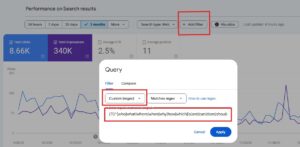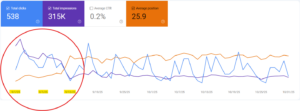In the world of search engine optimization (SEO), there are many metrics and tools that can help you create user-focused content that search engine algorithms love. Readability is just one of these metrics that writers, businesses, and marketers get hung up on as they produce online content.
As you start learning about readability, you will likely hear about the Flesch-Kincaid Readability Test.
What Is the Flesch-Kincaid Readability Test?
The Flesch-Kincaid Readability Test is actually a combination of two different tests that measure how difficult a passage of English text is to understand. Both tests factor in word and sentence length to grade how challenging a piece of content will be for readers to comprehend.
The first of these tests is the Flesch Reading Ease Test, which determines a school grade level that a text would correspond with based on the number of words per sentence and the number of syllables in each word. In fact, this test measures everything from magazines, books, and newspapers to college textbooks, scholarly articles, and online content. The Flesch Reading Ease Test is more usable than the Grade Level Test.
The second test is called the Flesch-Kincaid Grade Level Test. This part of the test is typically used only in the field of education, as it helps teachers, parents, and librarians determine the appropriate reading level for books for young students. Writers who come up with grade-level style readers use this test to make sure that they are keeping their books within the proper guidelines for each level of young readers.
The tests correlate in an inverse relationship. A piece of content with a high score on the Reading Ease Test will have a lower score on the Grade Level Test.

How Are Flesch Reading Ease Scores Calculated?
The Flesch Reading Ease Test uses the following formula to give a readability score.

The higher the score, the easier the text is to read. On this scale, a score of 100 to 90 would fall within a fifth-grade reading level, meaning that the average 11-year-old would easily understand the content. The following table describes all Flesch Reading Ease Scores:
| Score | School Grade Level | Notes |
| 100.0-90.0 | 5th grade | Very easy to read, even for the average 11-year-old. |
| 90.0-80.0 | 6th grade | Easy to read. Considered conversational English. |
| 80.0-70.0 | 7th grade | Fairly easy to read. |
| 70.0-60.0 | 8th-9th grade | Considered plain English, which is easily understood by 13- to 15-year-old students. |
| 60.0-50.0 | 10th-12th grade | Fairly difficult to read. |
| 50.0-30.0 | College | Difficult to read. |
| 30.0-10.0 | College graduate | Very difficult to read, and best understood by those who have graduated from college. |
| 10.0-0.0 | Professional | Extremely difficult to read, and best understood by those who have graduated from college. |
Occasionally, texts can receive scores that are higher or lower than this chart depicts, as well.
Why Was the Flesch-Kincaid Readability Test Developed?
Originally, Rudolf Flesch and J. Peter Kincaid developed this test for the United States Navy to assess how difficult the technical manuals of the time were for readers. However, today, these tests are used to create a standard of ninth-grade reading difficulty for legal documents, such as insurance policies, across the United States. This helps ensure that the average reader can understand what could be incredibly complex documents otherwise.
How Can You Use the Flesch Reading Ease Score in Your SEO-Focused Content?
Google looks at readability when it ranks content, and it uses the Flesch Reading Ease Score to do so. For Google, the idea is to mimic how a human reads content. This is why keyword stuffing is now problematic for web content. Like humans, Google wants to read something clear and easy to understand.
Read Now: How Will SEO and Content Marketing Continue to Merge in 2020?
Readability becomes incredibly important when using voice search. Those using voice search are likely to get confused if articles use long, complex sentences. Difficult words won’t translate to voice search as well as simpler terms.
However, the Flesch Reading Ease Score should not be your number one concern in creating SEO-friendly web content. There is a time and place to worry about readability based on a grade-level difficulty, but when it comes to businesses, you need to think about your audience, and how they search.
If your audience is middle school-aged children, then you will want to tailor your content to children at that reading level. At this point, your Flesch Reading Ease Score would be essential. For businesses or publications with adult audiences, your audience would likely be able to easily read content with a score of 60 or higher (easier), meaning that you will likely be able to create content that is appropriate for a high school reader. For reference, Reader’s Digest magazine creates content on the readability index near 65, and Time magazine hovers around 52.
Schools, medical professionals, law professionals, scientists, and other highly technical or specialized professions might write about topics that will require content that is difficult to read and falls in college or higher reading levels.
Searchers are likely to use the most commonly known phrases when searching. For this reason, your keywords shouldn’t be overcomplicated or shortened to try to meet a readability score. Stick to the keywords you found in your keyword research.
Business owners, digital marketers, and writers all must understand that readability testers, including the Flesch-Kincaid Readability Test, aren’t entirely accurate measurements of readability. Machines aren’t capable of accurately gauging the level of understanding of an audience.

Problems with the Flesch Reading Ease Test
The main problem with the Flesch Reading Ease Test is that it only considers word and sentence length, and not all long words or sentences are actually difficult to read. Additionally, content marketers, SEOs, and business owners often run into problems with company names and long-tail keywords having too many syllables or words to receive a decent score with the Flesch Reading Ease Test.
The Flesch Reading Ease Test is unable to determine how challenging a term would be based on vocabularic measures, so the syllable count is the best it can do. However, when you think about it, words like “overwhelming” and “population” are widely understood words with four syllables. On the other hand, “schmaltzed” is an incredibly obscure and challenging word with only a single syllable.
From this, we can determine that syllable count isn’t an accurate indicator of how difficult the word is to read. If a word’s difficulty isn’t determined by it being either monosyllabic or polysyllabic, the test is more of an estimation. The same can be said for sentence length. Some five-word sentences are more challenging than 20-word sentences. Therefore, the Flesch Reading Ease Test isn’t an accurate depiction of whether a piece of content is challenging or not.
Another challenge for web content writers is that the Flesch Reading Ease Test doesn’t read bulleted lists in the same way that humans do. A simple bulleted list is read as an entire sentence, which can lead to sentences being deemed way too long.
Finally, to make interesting content, you often need to craft sentences that could quickly contaminate your Flesch Reading Ease Score. It isn’t realistic to always stick to short, concise sentences when you have information to convey.
Tips for Improving Content Readability
Now that we know that Google takes readability-using the Flesch Reading Ease Test and other tests like it-into consideration when ranking content, it is time to mention how you can gain favor with Google in terms of readability. Here are a few tips for creating easy-to-read content that ranks.
1. Be Clear and Concise
The key to easy-to-read content is clarity. Using lengthy sentences puts you at risk for overly complex text. You want to make sure that you are balancing out longer sentences with shorter ones. By breaking up paragraphs into smaller chunks, you make it easier for readers to follow your content down the page, as well.
When explaining complicated topics, it is even more vital that you use concise language. Keep sentence structure and vocabulary as simple as possible and remember to be thorough. This means that your content might be quite long, which is fine. You just want to make sure that you are writing in a way that is clear and to the point
2. Create a Defined Structure
To make your content flow in a logical pattern, you need to develop a well-defined structure for your text. By giving your content a defined structure, you will help readers make their way through your page or blog. Use headers to aid the readers who are skimming your text and make various sections of your content easily visible to readers.
3. Use Variety
Varied sentences are not only more interesting to your readers, but they also help with readability. Repetition can lead to confusion. Start sentences with different words and use a variety of different keywords to make your content relevant across numerous searches for appropriate search terms.
4. Be Mindful of Keywords
Old practices that involve overloading your content with keywords are no longer relevant. This practice, called keyword stuffing, will now get your website in trouble with Google’s algorithm. Instead of cramming keywords into your content, write naturally while focusing on a few valuable long-tail keywords.
SEO-Focused Content at Rank Fuse Digital Marketing
While Google does take readability into account, at Rank Fuse Digital Marketing, we focus more on a piece of content as a whole. We consider the other ranking factors, such as keywords, high-quality content that answers questions users are asking, and positive user experience, as well. In fact, we focus a lot more on all the other ranking factors than we do readability. We do try to keep our readability scores in an average adult readership range, but we don’t write differently just to please the test.
In the humble opinion of just one writer (well, maybe not just one) the Flesch Reading Ease Score is no great indicator of how well a piece of online content should rank. And it isn’t even clear how Google uses readability in its ranking factors. It is unclear whether Google weighs readability is higher than some of the other ranking factors, as well. However, we still don’t suggest sacrificing keywords for the sake of readability.
Instead, we recommend focusing on writing in a manner that is clear and to the point. Don’t worry about arbitrary constraints for the number of words in a sentence or syllables per word. Use appropriate vocabulary and avoid jargon that the average reader wouldn’t understand.
Click here to read our guide to creating content for your website.
At the end of the day, the goal of SEO is to create content that ranks under relevant searches, so that should be the main focus of your content.
To learn more about how Rank Fuse Digital Marketing creates SEO-focused content, contact our team today!




